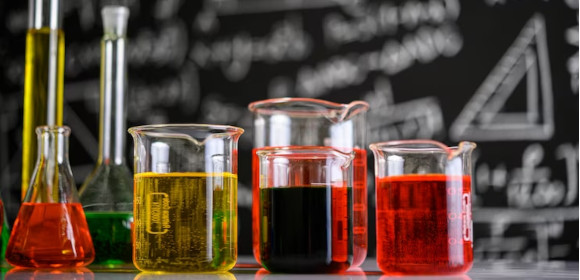What is the product of a neutralization reaction between an acid and a base?
Water and salt
Water and carbon dioxide
Salt and hydrogen gas
Oxygen and water


When we eat our food, the body breaks down the food bits into nutrients for the body to absorb as chemical energy. The breaking down process allows the organism to absorb the nutrients as energy through an exothermic reaction, which is the fundamental elementof the food web, food chain, and biosphere. This breaking down of food bits in our digestive system or track is a key example of chemical reactions.
A chemical reaction is a type of reaction that occurs when two or more substances is applied a specific energy or pressure to conduct a specific reaction to create a new substance or mixture. The chemical reaction will often result in an irreversible chemical change and physical change.
You can write down the chemical reaction as a chemical equation that will succinctly describe the interaction of two or more reactants and their resulting products. If you want to know more about how a chemical reaction is written or a template of a chemical reaction, you may read up on the following articles on the links above named chemical reactions evidence of reaction, rates of chemical reactions, and chemical reaction engineering.
Begin by identifying the reactants of the chemical formula and overall chemical reactions. This will help create a visual representation and provide the context of all the chemicals present in the formula and will create the outline overall chemical equation.
After writing down the reactants, you must ensure that each reactant has the correct coefficients that result in a charge of zero. If it does not have the correct coefficient and subscript, correct the chemical equation to have the proper coefficients. This step is important as the output should be a balanced chemical equation or a balanced equation.
The arrow will be the symbol that will separate the reactants from the products. Not only will this symbol separate all the elements of the chemical reaction, but it will also indicate the direction of the overall reaction.
After writing everything down, you must write down the correct products in the location where the arrow is pointing. Be sure to write down and label the correct coefficients for the products.
The reactants, arrow, and products are the three essential components of a chemical reaction. The substances or elements that scientists mix and put through various chemical transformations are known as reactants. The reaction’s arrow denotes the separation of reactant and product as well as the production of products from the reactant.
There are plenty of real-life examples of chemical reactions that we can observe outside of the laboratory setting. One of these is the chemical reaction of plants and producers that causes their pigments to appear green, photosynthesis is the main chemical reaction that facilitates the plants’ ability to absorb solar energy and transform it into chemical energy through an endothermic process.
The primary mechanism assisting the production of matter in the cosmos is chemical processes. Every element is a chemical compound, and the groups of elements that connect are known as molecules. When molecules contact, the atoms in the molecules break their bonds and a chemical reaction occurs. We may learn about a substance’s qualities by studying chemical reactions.
Chemical reactions are a type of reaction that occurs when two or more substances cause a reaction that creates a chemical solution. One can identify a chemical reaction when a chemical change occurs in the resulting substance. Most chemical reactions cannot be undone and will require an extensive amount of other chemical reactions to return them to their original state.
Text prompt
Add Tone
10 Examples of Public speaking
20 Examples of Gas lighting
What is the product of a neutralization reaction between an acid and a base?
Water and salt
Water and carbon dioxide
Salt and hydrogen gas
Oxygen and water
Which of the following is an example of a combustion reaction?
AgNO₃ + NaCl → AgCl + NaNO₃
H₂O → H2 + O₂
NaOH + HCl → NaCl + H₂O
2H₂+ O₂ → 2H₂O
In a redox reaction, which substance gets oxidized?
The substance that gains electrons
The substance that loses electrons
The substance that gains protons
The substance that loses protons
Which of the following indicates a chemical reaction has taken place?
Change in temperature
Change in color
Formation of a gas
All of the above
What is the general form of a synthesis reaction?
A + B → AB
AB → A + B
AB + CD → AD + CB
A + B → C + D
Which type of reaction is represented by the equation: AB → A + B?
Decomposition
Synthesis
Combustion
Single replacement
In a chemical reaction, the substances that start the reaction are called:
Products
Reactants
Catalysts
Intermediates
What is the catalyst's role in a chemical reaction?
It increases the amount of reactants
It increases the reaction rate
It decreases the reaction rate
It changes the reactants into products
Which of the following is a characteristic of an endothermic reaction?
Releases heat
Absorbs heat
Produces light
Forms a precipitate
What is the purpose of balancing a chemical equation?
To show the ratio of reactants and products
To show the physical states of reactants and products
To indicate the rate of reaction
To show the temperature of the reaction
Before you leave, take our quick quiz to enhance your learning!

